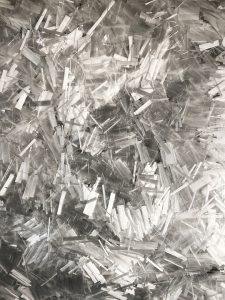Introduction to modified nylon 0
The special properties of nylon make it widely used in automobiles, electronic and electrical equipment, mechanical structures, sports equipment, textiles, and other fields.
But with the miniaturization of automobiles, the high performance of electronic and electrical equipment, and the acceleration of the process of lightweighting mechanical equipment, the demand and performance requirements for nylon are gradually increasing. Therefore, the modification of nylon becomes particularly important.

Precautions for Nylon Modification:
- Material barrel temperature setting
(1) As nylon is a crystalline polymer, its melting point is obvious. The temperature of the barrel selected for injection molding of nylon resins is related to the properties of the resin itself, equipment, and the shape of the product.
(2) Excessive material temperature can cause color change, brittleness, and silver threads in the rubber parts, while excessively low material temperature can make the material hard and potentially damage the mold and screws.
(3) The minimum melt temperature for PA6 is generally 220 ℃, while for PA66 it is 250 ℃. Due to the poor thermal stability of nylon, it is not suitable to stay in the barrel at high temperatures for a long time to avoid discoloration and yellowing of the material. At the same time, due to the good fluidity of nylon, it flows rapidly when the temperature exceeds its melting point.

- Setting of mold temperature
(1) The mold temperature has a certain impact on crystallinity and molding shrinkage, and the range of mold temperature is between 80-120 ℃. Choosing high mold temperature, high crystallinity, increased wear resistance, hardness, and elastic modulus, decreased water absorption, increased molding shrinkage rate of the product, suitable for thick products; Choose low mold temperature, low crystallinity, good toughness, high elongation, and reduced shrinkage, suitable for thin products with good transparency.
(2) If the wall thickness is greater than 3mm, it is recommended to use a low-temperature mold at 20~40 ℃. For glass reinforced material molds, the temperature should be greater than 80 ℃.
(3) For molds with thin walls that are difficult to form or require high crystallinity, cold water temperature control is generally used for molds that require a certain degree of flexibility.
- Wall thickness of the product
The flow length ratio of nylon is 150-200, and the wall thickness of the product is not less than 0.8mm, generally selected between 1-3.2mm. Moreover, the shrinkage of the product is related to its wall thickness, and the thicker the wall thickness, the greater the shrinkage.
- Exhaust gas
The overflow value of nylon resin is about 0.03mm, so the exhaust hole groove should be controlled below 0.025.
- Runner and sprue
The gate aperture should not be less than 0.5t (t is the thickness of the plastic part). The minimum diameter of the submerged gate should be 0.75mm.
- Range of fiberglass filling amount
During the molding process of nylon, reducing the mold temperature, increasing the injection pressure, and lowering the material temperature can all reduce the shrinkage rate of nylon to a certain extent, leading to increased internal stress and easy deformation of the product. For example, the shrinkage rate of PA66 is between 1.5% and 2%, and the shrinkage rate of PA6 is between 1% and 1.5%. Adding glass fiber additives can reduce the shrinkage rate to around 0.3%. Practical experience tells us that the more glass fiber is added, the smaller the molding shrinkage rate of nylon resin. However, adding too much fiberglass can cause surface floating fibers, poor compatibility, and other consequences. Generally, adding 30% is more effective.

- The use of recycled materials
It is best not to exceed three times to avoid discoloration or a sharp decline in physical and mechanical properties of the product. The application amount should be controlled below 25%, as excessive use can cause fluctuations in process conditions. The mixture of recycled and new materials must be dried.
- Safety Notice
When starting up nylon resin, the nozzle temperature should be turned on first, and then the feeding cylinder should be heated. When the nozzle is blocked, avoid facing the spray hole to prevent the molten material in the cylinder from suddenly releasing due to pressure accumulation, which may cause danger.
- Use of release agent
The use of a small amount of release agent sometimes has the effect of improving and eliminating defects such as bubbles. The release agent for nylon products can be selected from zinc stearate and white oil, or mixed into a paste for use. When using, the amount must be small and uniform to avoid surface defects on the product. When shutting down, the screw should be emptied to prevent it from twisting and breaking during the next production.

- Post processing
(1) After the product is formed, it needs to undergo heat treatment
The commonly used method is to heat treat high boiling point liquids such as mineral oil, glycerin, and liquid paraffin at a temperature 10-20 ℃ higher than the operating temperature. The treatment time varies depending on the wall thickness of the product, with 10-15 minutes for thicknesses below 3mm and 15-30 minutes for thicknesses between 3-6mm. Products that have undergone heat treatment should be slowly cooled to room temperature to prevent stress regeneration caused by rapid cooling.
(2) After the product is formed, it needs to undergo humidity control treatment
Humidity control treatment is mainly carried out for products with high humidity in the usage environment, and there are two methods:
One is the wet method of boiling water adjustment;
The second method is the potassium acetate aqueous solution hydrometallurgy (potassium acetate to water ratio of 1.25:1, boiling point 121 ℃).
Boiling water wet conditioning is simple, as long as the product is placed in an environment with a humidity of 65% to achieve equilibrium moisture absorption, but the time is longer. The treatment temperature of potassium acetate aqueous solution wet conditioning is 80-100 ℃, and the treatment time mainly depends on the wall thickness of the product. When the wall thickness is 1.5mm, it is about 2h, 3mm, it is about 8h, and 6mm, it is 16-18h.
Four Case Analysis
- Glass fiber reinforced nylon
Adding 30% glass fiber to nylon significantly improves its mechanical properties, dimensional stability, heat resistance, and aging resistance. Its fatigue strength is 2.5 times that of unreinforced nylon. The molding process of glass fiber reinforced PA is roughly the same as before reinforcement, but due to the difference in flow compared to before reinforcement, the injection pressure and injection speed should be appropriately increased, and the barrel temperature should be increased by 10-40 ℃. Due to the orientation of fiberglass along the flow direction during injection molding, the mechanical properties and shrinkage rate increase in the orientation direction, resulting in deformation and warping of the product.
Therefore, when designing the mold, the position and shape of the sprue should be reasonable, and the temperature of the mold can be increased in the process. After the product is taken out, it should be slowly cooled in hot water. In addition, the larger the proportion of glass fiber added, the greater the wear on the plasticizing components of the injection molding machine. It is best to use bimetallic screws and barrels.
- Flame retardant nylon
Due to the addition of flame retardants in nylon, most of them are prone to decomposition at high temperatures, releasing acidic substances that have a corrosive effect on metals.
Therefore, plasticized components (screws, rubber heads, rubber rings, rubber gaskets, flanges, etc.) need to be plated with hard chromium. In terms of process, try to control the temperature of the barrel as much as possible, and the injection speed should not be too fast to avoid discoloration and mechanical performance degradation of the product caused by the decomposition of the rubber material due to high temperature.
- Transparent Nylon
It has good tensile strength, impact resistance, rigidity, wear resistance, chemical resistance, surface hardness and other properties. It has high light transmittance and is similar to optical glass. The processing temperature is 300-315 ℃. During molding, the temperature of the machine barrel needs to be strictly controlled. If the melt temperature is too high, it will cause degradation and discoloration of the product. If the temperature is too low, it will affect the transparency of the product due to poor plasticization. The mold temperature should be kept as low as possible, as high mold temperatures can reduce the transparency of the product due to crystallization.
- Weather resistant nylon
Adding UV absorbing additives such as carbon black to nylon greatly enhances its self-lubricating properties and metal wear, which can affect the cutting and wear of parts during molding and processing.
Therefore, it is necessary to use a combination of screws, barrels, rubber heads, rubber rings, and rubber gaskets with strong feeding capacity and high wear resistance. The experience content is for reference only. If you need to solve specific problems (especially in the fields of law, medicine, etc.), we recommend that you consult relevant professionals in detail.
PRIME CHEMICALS are experienced in polymers, chemicals and modified plastic materials for more than 23 years. If there is any inquiry, welcome to contact us and Whatsapp: 0086 13817820852.
#Nylon # Modified Nylon # Automotive # Electronic and Electrical Equipment # Mechanical Mechanism # Sports Equipment # Textile # PA6 # PA66 # PA12 # Release Agent # Glycerol # Mineral Oil # Liquid Paraffin # Potassium Acetate # Glass Fiber Reinforced Nylon # Flame retardant Nylon # Transparent Nylon # Weather resistant Nylon




